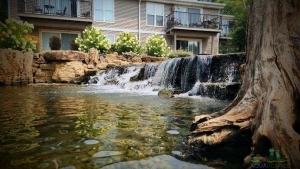A backyard pond can be a captivating and serene addition to any landscape, offering a slice of nature right at your doorstep. However, like any water feature, ponds come with their fair share of challenges. In this guide, we will explore common pond problems and provide effective troubleshooting tips to keep your aquatic oasis thriving.
- Algae Overgrowth:
Algae are a common woe for pond owners, turning crystal-clear water into a murky green mess. To combat algae overgrowth, consider the following strategies:
a. Balance the ecosystem: Introduce aquatic plants that compete with algae for nutrients, helping maintain a healthier balance in your pond.
b. Install aeration systems: Oxygenating the water through pumps or fountains discourages algae growth, as many species thrive in low-oxygen environments.
c. Regular cleaning: Remove debris and decaying organic matter to eliminate potential nutrient sources for algae.
- Leaks:
A leaking pond can lead to water loss, damaging the ecosystem and potentially causing structural issues. Follow these steps to identify and fix leaks:
a. Visual inspection: Look for damp spots, soggy soil, or visible cracks along the pond liner or edges.
b. Water level monitoring: Regularly check the water level to detect any unexplained drops.
c. Patch and seal: Once you identify the leak, use a pond liner patch kit to seal small holes. For larger issues, consider professional help.
- Water Quality Issues:
Maintaining optimal water quality is crucial for the health of your pond’s inhabitants. Address these common water quality problems:
a. pH levels: Test and adjust the pH to ensure it falls within the ideal range for your pond’s ecosystem.
b. Ammonia and nitrate control: Implement a biofilter to break down harmful compounds, keeping ammonia and nitrate levels in check.
c. Regular water testing: Periodically test the water for key parameters such as ammonia, nitrate, and dissolved oxygen levels.
- Invasive Plants and Weeds:
While plants contribute to a pond’s aesthetics, invasive species can wreak havoc on the ecosystem. Take these steps to manage unwanted vegetation:
a. Manual removal: Regularly pull out invasive plants by hand to control their spread.
b. Biological control: Introduce herbivorous fish, like koi or grass carp, to help keep plant growth in check.
c. Use herbicides cautiously: If necessary, use herbicides specifically designed for aquatic environments, but do so with caution to avoid harming other pond life.
Owning a pond comes with the responsibility of troubleshooting and maintaining its delicate balance. By understanding and addressing common issues like algae overgrowth, leaks, and water quality problems, you can ensure that your pond remains a thriving ecosystem and a source of tranquility for years to come. Regular observation, preventive measures, and timely interventions are the keys to a healthy and vibrant pond in your backyard.
Check out our store for all your water gardening needs! Aquascape products are Aquascape Inc. Certified.
Thanks for reading at Meyer Aquascapes! We hope you’ve enjoyed our post on garden pond design. Please leave a comment below if you liked it or have any questions. We’d love to hear from you! Thanks for stopping by!



